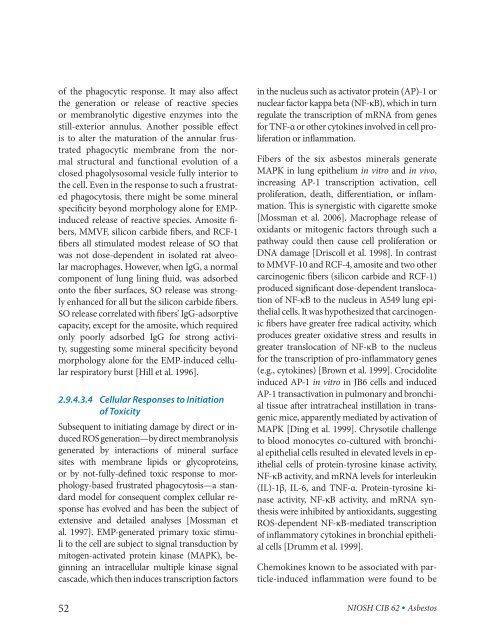Asbestos Fibers and Other Elongate Mineral Particles: State of the ...
Asbestos Fibers and Other Elongate Mineral Particles: State of the ...
Asbestos Fibers and Other Elongate Mineral Particles: State of the ...
- No tags were found...
Create successful ePaper yourself
Turn your PDF publications into a flip-book with our unique Google optimized e-Paper software.
<strong>of</strong> <strong>the</strong> phagocytic response. It may also affect<br />
<strong>the</strong> generation or release <strong>of</strong> reactive species<br />
or membranolytic digestive enzymes into <strong>the</strong><br />
still-exterior annulus. Ano<strong>the</strong>r possible effect<br />
is to alter <strong>the</strong> maturation <strong>of</strong> <strong>the</strong> annular frustrated<br />
phagocytic membrane from <strong>the</strong> normal<br />
structural <strong>and</strong> functional evolution <strong>of</strong> a<br />
closed phagolysosomal vesicle fully interior to<br />
<strong>the</strong> cell. Even in <strong>the</strong> response to such a frustrated<br />
phagocytosis, <strong>the</strong>re might be some mineral<br />
specificity beyond morphology alone for EMPinduced<br />
release <strong>of</strong> reactive species. Amosite fibers,<br />
MMVF, silicon carbide fibers, <strong>and</strong> RCF-1<br />
fibers all stimulated modest release <strong>of</strong> SO that<br />
was not dose-dependent in isolated rat alveolar<br />
macrophages. However, when IgG, a normal<br />
component <strong>of</strong> lung lining fluid, was adsorbed<br />
onto <strong>the</strong> fiber surfaces, SO release was strongly<br />
enhanced for all but <strong>the</strong> silicon carbide fibers.<br />
SO release correlated with fibers’ IgG- adsorptive<br />
capacity, except for <strong>the</strong> amosite, which required<br />
only poorly adsorbed IgG for strong activity,<br />
suggesting some mineral specificity beyond<br />
morphology alone for <strong>the</strong> EMP-induced cellular<br />
respiratory burst [Hill et al. 1996].<br />
2.9.4.3.4 Cellular Responses to Initiation<br />
<strong>of</strong> Toxicity<br />
Subsequent to initiating damage by direct or induced<br />
ROS generation—by direct membranolysis<br />
generated by interactions <strong>of</strong> mineral surface<br />
sites with membrane lipids or glycoproteins,<br />
or by not-fully-defined toxic response to morphology-based<br />
frustrated phagocytosis—a st<strong>and</strong>ard<br />
model for consequent complex cellular response<br />
has evolved <strong>and</strong> has been <strong>the</strong> subject <strong>of</strong><br />
extensive <strong>and</strong> detailed analyses [Mossman et<br />
al. 1997]. EMP-generated primary toxic stimuli<br />
to <strong>the</strong> cell are subject to signal transduction by<br />
mitogen-activated protein kinase (MAPK), beginning<br />
an intracellular multiple kinase signal<br />
cascade, which <strong>the</strong>n induces transcription factors<br />
52<br />
in <strong>the</strong> nucleus such as activator protein (AP)-1 or<br />
nuclear factor kappa beta (NF-κB), which in turn<br />
regulate <strong>the</strong> transcription <strong>of</strong> mRNA from genes<br />
for TNF-α or o<strong>the</strong>r cytokines involved in cell proliferation<br />
or inflammation.<br />
<strong>Fibers</strong> <strong>of</strong> <strong>the</strong> six asbestos minerals generate<br />
MAPK in lung epi<strong>the</strong>lium in vitro <strong>and</strong> in vivo,<br />
increasing AP-1 transcription activation, cell<br />
proliferation, death, differentiation, or inflammation.<br />
This is synergistic with cigarette smoke<br />
[Mossman et al. 2006]. Macrophage release <strong>of</strong><br />
oxidants or mitogenic factors through such a<br />
pathway could <strong>the</strong>n cause cell proliferation or<br />
DNA damage [Driscoll et al. 1998]. In contrast<br />
to MMVF-10 <strong>and</strong> RCF-4, amosite <strong>and</strong> two o<strong>the</strong>r<br />
carcinogenic fibers (silicon carbide <strong>and</strong> RCF-1)<br />
produced significant dose-dependent translocation<br />
<strong>of</strong> NF-κB to <strong>the</strong> nucleus in A549 lung epi<strong>the</strong>lial<br />
cells. It was hypo<strong>the</strong>sized that carcinogenic<br />
fibers have greater free radical activity, which<br />
produces greater oxidative stress <strong>and</strong> results in<br />
greater translocation <strong>of</strong> NF-κB to <strong>the</strong> nucleus<br />
for <strong>the</strong> transcription <strong>of</strong> pro-inflammatory genes<br />
(e.g., cytokines) [Brown et al. 1999]. Crocidolite<br />
induced AP-1 in vitro in JB6 cells <strong>and</strong> induced<br />
AP-1 transactivation in pulmonary <strong>and</strong> bronchial<br />
tissue after intratracheal instillation in transgenic<br />
mice, apparently mediated by activation <strong>of</strong><br />
MAPK [Ding et al. 1999]. Chrysotile challenge<br />
to blood monocytes co-cultured with bronchial<br />
epi<strong>the</strong>lial cells resulted in elevated levels in epi<strong>the</strong>lial<br />
cells <strong>of</strong> protein-tyrosine kinase activity,<br />
NF-κB activity, <strong>and</strong> mRNA levels for interleukin<br />
(IL)-1β, IL-6, <strong>and</strong> TNF-α. Protein-tyrosine kinase<br />
activity, NF-κB activity, <strong>and</strong> mRNA syn<strong>the</strong>sis<br />
were inhibited by antioxidants, suggesting<br />
ROS-dependent NF-κB-mediated transcription<br />
<strong>of</strong> inflammatory cytokines in bronchial epi<strong>the</strong>lial<br />
cells [Drumm et al. 1999].<br />
Chemokines known to be associated with particle-induced<br />
inflammation were found to be<br />
NIOSH CIB 62 • <strong>Asbestos</strong>

















